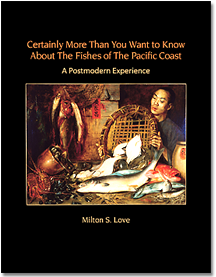 There is a website floating around the interwebs entitled “So you want to be a marine biologist?” that most future marine biologists who came of age in the early 21st century have encountered. The sage page of advice is followed up with “So you want to be a marine biologist, the revenge“. Reading through these two essays, one might come to the conclusion that their author, Dr. Milton Love of the University of California, Santa Barbara, should compose a voluminous tome to the fishes of the Pacific coast. Which is exactly what he’s done. Welcome to Certainly More Than You Want to Know About The Fishes of The Pacific Coast: a postmodern experience.
There is a website floating around the interwebs entitled “So you want to be a marine biologist?” that most future marine biologists who came of age in the early 21st century have encountered. The sage page of advice is followed up with “So you want to be a marine biologist, the revenge“. Reading through these two essays, one might come to the conclusion that their author, Dr. Milton Love of the University of California, Santa Barbara, should compose a voluminous tome to the fishes of the Pacific coast. Which is exactly what he’s done. Welcome to Certainly More Than You Want to Know About The Fishes of The Pacific Coast: a postmodern experience.
Despite it’s self-aware title, this book is far more than just an exhaustive guide to the fishes of the Pacific, though it certainly is that. The highly detailed taxonomic descriptions are rich with humor and insight into the ecology, behavior, and physiology of, if not each species, than each genus or species complex. Interspersed among the taxa are descriptions of prominent Pacific researchers, anecdotes from a lifetime of work on the water, stories by people who lived, worked, and fished these species, and the occasional poem, song, or limerick. Somehow, these disparate units manage to complement each other in a way that makes you want to read what is essential a taxonomy textbook cover-to-cover.
In honor of my shark-loving blogmates, I couldn’t resist the following quotes:
On Spiny Dogfish: “Like the splendidly deformed Richard III, the spiny dogfish is the fish everyone loves to hate.”
On Whale Sharks: “It’s both the biggest fish in the world and covered with large spots. What’s not to like?”
On Great White Sharks: “A Jungian archetype with serrated teeth.”
While Dr. Love is consistently hilarious throughout his species descriptions, he also provides an unbelievable amount of information, more than you would expect from a book spanning the entire left-coast piscine assemblage.
Perhaps the most insightful sections within this apparently limitless treatise are those pertaining to the fisheries that have cropped up around various species. These range from the succinct “none known” to a comprehensive multi-page primer on Pacific salmon fisheries. Rarely judgmental, consistently sympathetic, but unapologetically critical of the causes (and cause-ers) of over-fishing, Love draws from the experience of scientists, fishermen, and historical documents, to paint a picture of the rise and fall (and rise) of Pacific fisheries. Were just the sections on fisheries extracted from the text, they could form their own, only slightly slimmer, volume.
If I have one criticism, it is that the book is heavily weighted towards the author’s favored species. Much of Love’s research focuses on rockfish, so it is not surprising that the rockfish section, a full 9.53% of the entire book, is the most detailed. It is readily apparent that he took particular delight composing this section. Not that this detracts from the other sections, but it is noticeable when a single genus occupies as many column inches as all elsamobranchs and is twice as long as the equally well-studied salmonids.
The language is approachable without being patronizing, suitable for students of Pacific fisheries and interested laypeople. The illustrations are brilliant, every page is adorned with glorious, glossy, full color photographs of the species in question – which is remarkable considering its $30 price tag. As an extra bonus, Dr. Love will autograph copies ordered through Really Big Press. For any fans of fishes, marine science, or the history of the Pacific coast, Certainly More Than You Want to Know About The Fishes of The Pacific Coast: a postmodern experience is money well spent.
Disclaimer: The author provided a copy for me to review.

I might have to pick this book up for the dogfish description alone. Does he call them Squalus acanthias or suckleyi?
Someday, I want to write a version of this for bacteria (Dyer’s Field Guide to Bacteria is amusing, but not quite on the maniac level as this seems to be)